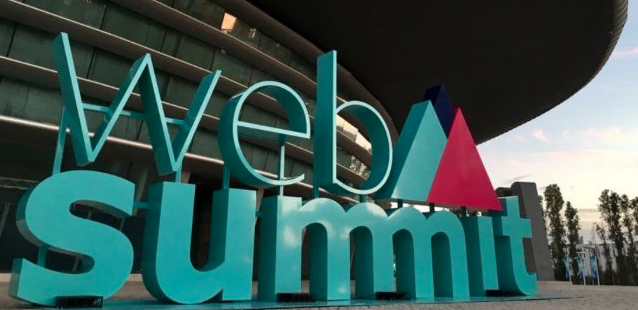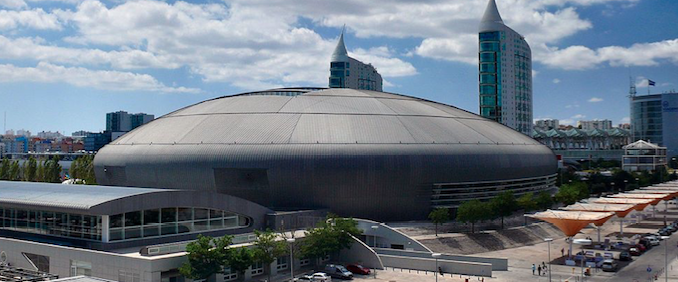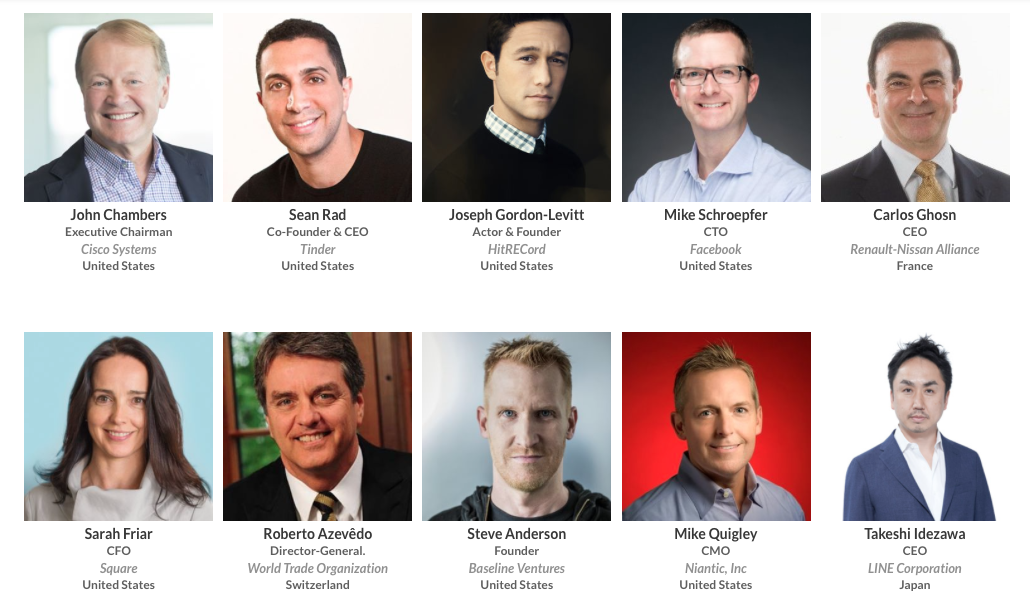Web Summit Lisbon Conference Overview
2 weeks after the Web Summit in Lisbon, I finally wrote my impressions. Web Summit is an IT conference that was born in Dublin and in 7 years has evolved from a gathering of local bloggers and entrepreneurs into the largest conference in Europe with 50,000 audiences and speakers such as Ilon Musk, Peter Thiel, Drew Houston, Tony Hawk and even Russians Volozh and Kaspersky.
This is my 4th Web Summit, and every year I observe what work the organizers do to gather tough speakers and satisfy a crowd of thousands of geeks (as they call their audience). The first three years I went to gain experience and look for speakers for the MBLT and MBLTDev conferences , this year I went not from e-Legion, but from the Irish investment fund Lucey Fund to look for new startups.
I hope my post will help you decide whether to go next year or not.
Details under the cut.
')

This year, the conference left Dublin for Lisbon. The main reason, according to the organizer, Paddy Cosgrave, was the poor infrastructure of the capital of Ireland, the lack of a conference venue (still, you need to somehow comfortably accommodate 50,000 people) and the Irish authorities' refusal to cooperate (one of the conditions for the conference was a police escort VIP speakers haha). Who is interested, you can read an article in The Irish Times on this topic.
So that you understand the scope of the conference, I’ll tell you that the Web Summit 2016 was held in the complex built for Expo 98 and included 4 huge pavilions and a MEO arena for 20,000 people, where everything from A-HA and Kiss to Madonna and Justin Bieber.
Summit posters hung on every corner, not only at the airport, but also in the city, the logo appeared on the screensaver of urban wifi, and huge signs stood in the most crowded places of Lisbon.

Hand on heart, the Summit in Lisbon was better than Dublin. The city easily accommodated 53,000 people, the metro (which is absent in Dublin) took 40 minutes from the venue to the city center (and the center of all parties), the Internet did not fall (in Dublin, not only wifi did not work, it was also just mobile the connection was lame), there was no wild talk of stands around the stands. In addition, for all participants, the organizers knocked out a single ticket for any type of transport for a week twice cheaper than usual (25 euros against 50). Not bad, huh?
This year, the organizers made the opening on Monday evening, they increased the conference to 3.5 days. Of course, the arena, which seats 20,000 people, was unable to explode and the rest had to stand on the street in line. In general, I heard a lot of disturbances about the queues at the stage, at the food, in the toilet, but these people clearly have no idea how to organize large events, or have not guessed to leave the conference center and go to eat in the cafe, which was in bulk around.
The conference will remain in Lisbon for another two years, and then leave. Maybe to Barcelona. Or Berlin. Or somewhere else. Wait and see.
I did not have time for everything that happened in the city during these 4 days, but I will try to give a small overview of what I was on.

Web Summit 2016 gathered 650+ speakers from around the world. Harry Vaynerchuk, Facebook, CEO LINE, CFO Square, founder of Product Hunt, football players Ronaldinho and Luis Figo, actor Joseph Gordon-Levitt, became the main ones. They even brought Miroslav Duma and the Vatican's Culture Secretary (not sure how to transfer his position correctly), who, as they say, persuaded the Pope to create an account on Twitter.
By the way, he turned out to be a very good speaker, did not preach, but merely told that even the church has to change and adapt to the world of digital.

The coolest was the robot Sofia from Hanson Robotics, which behaves and speaks almost like a human being. Her facial expressions, movements and voice are simply amazing. I did not shoot, but found a video , look.

It was difficult to burst between the 17 streams, and it is unrealistic to run from one scene to another in 5 minutes. Well, rarely anyone attending conferences just to listen to speakers. It was more important for me to communicate with visitors and startups, I can listen to the speakers and record after. True, I still managed to capture a couple of speeches. Canadian Branch 500 Startups partner Sanjay Singhal spoke very well about how startups need to communicate with investors: “Every time I am asked to sign an NDA, the most polite answer becomes“ f * ck off ”. We receive hundreds of applications a day, do you seriously think that we will steal your ideas? ” Or "We will never invest in people who meet. If they are married, then no problem, but if they are engaged and the wedding is already tomorrow - no. Such a relationship never ends well. ”

To prevent people from getting bored in front of the bars, a Sunset Summit was organized, in which the Portuguese talked about their country. It is worth saying that the warmed up Portuguese wine and gin, all happily and cheerfully rode on Pink Street or Bairro Alto, where the main networking took place. I am very interested to know how much the bars have earned during these 4 days, because on Friday both districts were almost empty.
During the conference and on Friday after:

Who is interested to see the scope of the Night Summit, see the map .

Fifteen hundred startups were divided into three sectors: START for those who are already running, BETA for growth-stage and ALPHA for early-stage guys. One of the main trends are AR and VR startups and various additions to them.
After walking between them and talking with the founders, I met a lot of the same ideas or repetition of those that already exist. Of course, it may make sense to launch a local TripAdvisor or a regular travel planner in Indonesia, they know their market better, but this is not the case in Europe and America. Working in the investment fund, every day I come across guys who decide to build a new Amazon or Uber, and get upset when you tell them that their idea is unlikely to be profitable.
Investors complained very much about the lack of preparation of alpha startups, that they not only didn’t make worthy presentations, but even didn’t have any basic market analysis. As a result, investors were stupidly losing time on Monday pitches. This raises the question, how did the organizers select them at all?
The organizers said that participants from 166 countries came to them, which is 32 countries more than last year. One of the innovations has become free tickets Women in Tech. In Europe and America, gender equality made a lot of noise, and the organizers decided that since women earn less, they should be given free tickets. You should have seen the number of tweets from men with outrage! And now the stones will fly into me, but partly I agree with them, because half have arrived there only because of the free ticket, without knowing at all why they are there. For some reason in Russia I didn’t feel hurt, but as soon as I moved to Europe, I started right away. There are so many activities for women and they shout so loudly about equality that somehow this feeling eats into you subconsciously.But about March 8, they did not hear.
By the way, this year I met a lot of Russians. No wonder, you need to get either a British or Irish visa to Ireland, and you can easily come here with a Schengen.

If you are interested in talking with businessmen from all over the world, look for investors, find out trends and say that you saw Alona Mask alive, you are here. Even if you are not working in a startup and are not looking for investors, the Web Summit is a great place, first of all, for networking and collecting content. And even more so if you are thinking about creating your own company. For you, the conference will be a good place for gathering feedback and honing the pitch. And I want to believe that next year the quality will not fall.
And here you can see all the performances.
This is my 4th Web Summit, and every year I observe what work the organizers do to gather tough speakers and satisfy a crowd of thousands of geeks (as they call their audience). The first three years I went to gain experience and look for speakers for the MBLT and MBLTDev conferences , this year I went not from e-Legion, but from the Irish investment fund Lucey Fund to look for new startups.
I hope my post will help you decide whether to go next year or not.
Details under the cut.
')

This year, the conference left Dublin for Lisbon. The main reason, according to the organizer, Paddy Cosgrave, was the poor infrastructure of the capital of Ireland, the lack of a conference venue (still, you need to somehow comfortably accommodate 50,000 people) and the Irish authorities' refusal to cooperate (one of the conditions for the conference was a police escort VIP speakers haha). Who is interested, you can read an article in The Irish Times on this topic.
So that you understand the scope of the conference, I’ll tell you that the Web Summit 2016 was held in the complex built for Expo 98 and included 4 huge pavilions and a MEO arena for 20,000 people, where everything from A-HA and Kiss to Madonna and Justin Bieber.
Summit posters hung on every corner, not only at the airport, but also in the city, the logo appeared on the screensaver of urban wifi, and huge signs stood in the most crowded places of Lisbon.

Hand on heart, the Summit in Lisbon was better than Dublin. The city easily accommodated 53,000 people, the metro (which is absent in Dublin) took 40 minutes from the venue to the city center (and the center of all parties), the Internet did not fall (in Dublin, not only wifi did not work, it was also just mobile the connection was lame), there was no wild talk of stands around the stands. In addition, for all participants, the organizers knocked out a single ticket for any type of transport for a week twice cheaper than usual (25 euros against 50). Not bad, huh?
This year, the organizers made the opening on Monday evening, they increased the conference to 3.5 days. Of course, the arena, which seats 20,000 people, was unable to explode and the rest had to stand on the street in line. In general, I heard a lot of disturbances about the queues at the stage, at the food, in the toilet, but these people clearly have no idea how to organize large events, or have not guessed to leave the conference center and go to eat in the cafe, which was in bulk around.
The conference will remain in Lisbon for another two years, and then leave. Maybe to Barcelona. Or Berlin. Or somewhere else. Wait and see.
I did not have time for everything that happened in the city during these 4 days, but I will try to give a small overview of what I was on.
Speakers

Web Summit 2016 gathered 650+ speakers from around the world. Harry Vaynerchuk, Facebook, CEO LINE, CFO Square, founder of Product Hunt, football players Ronaldinho and Luis Figo, actor Joseph Gordon-Levitt, became the main ones. They even brought Miroslav Duma and the Vatican's Culture Secretary (not sure how to transfer his position correctly), who, as they say, persuaded the Pope to create an account on Twitter.
By the way, he turned out to be a very good speaker, did not preach, but merely told that even the church has to change and adapt to the world of digital.

The coolest was the robot Sofia from Hanson Robotics, which behaves and speaks almost like a human being. Her facial expressions, movements and voice are simply amazing. I did not shoot, but found a video , look.

Program
It was difficult to burst between the 17 streams, and it is unrealistic to run from one scene to another in 5 minutes. Well, rarely anyone attending conferences just to listen to speakers. It was more important for me to communicate with visitors and startups, I can listen to the speakers and record after. True, I still managed to capture a couple of speeches. Canadian Branch 500 Startups partner Sanjay Singhal spoke very well about how startups need to communicate with investors: “Every time I am asked to sign an NDA, the most polite answer becomes“ f * ck off ”. We receive hundreds of applications a day, do you seriously think that we will steal your ideas? ” Or "We will never invest in people who meet. If they are married, then no problem, but if they are engaged and the wedding is already tomorrow - no. Such a relationship never ends well. ”

To prevent people from getting bored in front of the bars, a Sunset Summit was organized, in which the Portuguese talked about their country. It is worth saying that the warmed up Portuguese wine and gin, all happily and cheerfully rode on Pink Street or Bairro Alto, where the main networking took place. I am very interested to know how much the bars have earned during these 4 days, because on Friday both districts were almost empty.
During the conference and on Friday after:

Who is interested to see the scope of the Night Summit, see the map .
Startups

Fifteen hundred startups were divided into three sectors: START for those who are already running, BETA for growth-stage and ALPHA for early-stage guys. One of the main trends are AR and VR startups and various additions to them.
After walking between them and talking with the founders, I met a lot of the same ideas or repetition of those that already exist. Of course, it may make sense to launch a local TripAdvisor or a regular travel planner in Indonesia, they know their market better, but this is not the case in Europe and America. Working in the investment fund, every day I come across guys who decide to build a new Amazon or Uber, and get upset when you tell them that their idea is unlikely to be profitable.
Investors complained very much about the lack of preparation of alpha startups, that they not only didn’t make worthy presentations, but even didn’t have any basic market analysis. As a result, investors were stupidly losing time on Monday pitches. This raises the question, how did the organizers select them at all?
People
The organizers said that participants from 166 countries came to them, which is 32 countries more than last year. One of the innovations has become free tickets Women in Tech. In Europe and America, gender equality made a lot of noise, and the organizers decided that since women earn less, they should be given free tickets. You should have seen the number of tweets from men with outrage! And now the stones will fly into me, but partly I agree with them, because half have arrived there only because of the free ticket, without knowing at all why they are there. For some reason in Russia I didn’t feel hurt, but as soon as I moved to Europe, I started right away. There are so many activities for women and they shout so loudly about equality that somehow this feeling eats into you subconsciously.
By the way, this year I met a lot of Russians. No wonder, you need to get either a British or Irish visa to Ireland, and you can easily come here with a Schengen.

If you are interested in talking with businessmen from all over the world, look for investors, find out trends and say that you saw Alona Mask alive, you are here. Even if you are not working in a startup and are not looking for investors, the Web Summit is a great place, first of all, for networking and collecting content. And even more so if you are thinking about creating your own company. For you, the conference will be a good place for gathering feedback and honing the pitch. And I want to believe that next year the quality will not fall.
And here you can see all the performances.
Source: https://habr.com/ru/post/315878/
All Articles